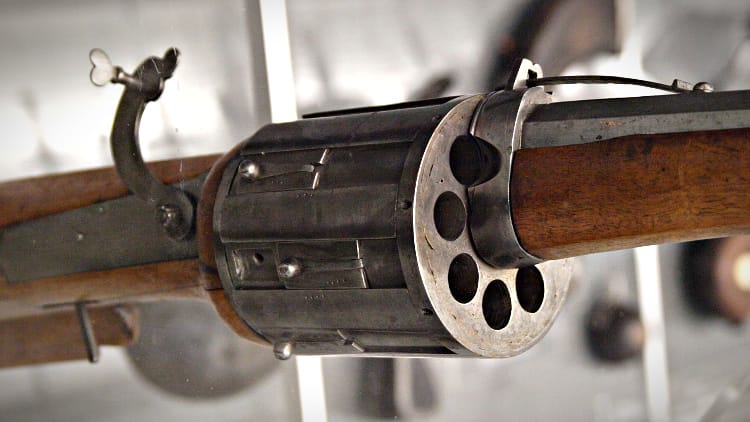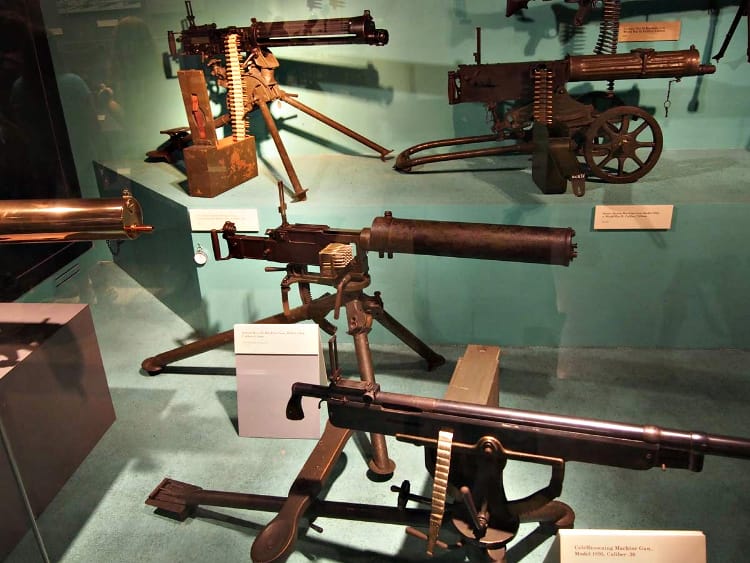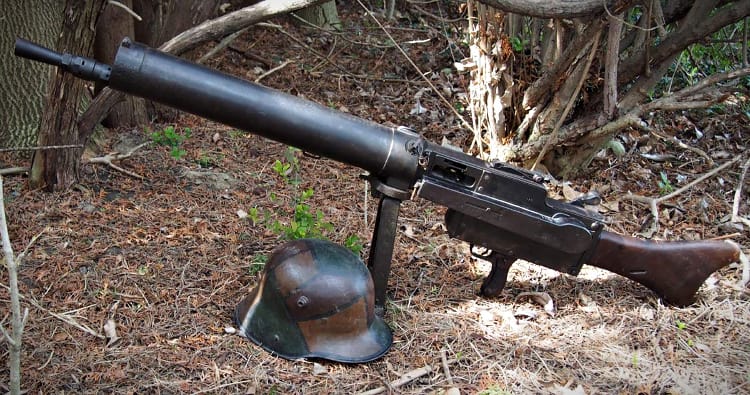In less than 150 years, the typical firearm rate of fire went from three (3) to six thousand (6,000) per minute.
We discuss that at length in today’s Throwback Thursday!
How’d we get here from there?
There is a scene in Sharpe’s Eagle, the made-for-TV movie based on the Bernard Cornwell book of the same name, where Lt. Richard Sharpe (Sean Bean) is instructing some British soldiers of the South Essex Regiment how to quickly load, aim, and fire their Brown Bess muskets. Set in the Napoleonic Wars, the scene is one of the more realistic moments in the fanciful series – as even trained & “professional” soldiers of the era could typically fire just three rounds per minute.
Matchlocks
In fact, in the 15th century, the general rate of fire for matchlocks (the earliest form of firearms) was seldom more than three rounds per minute. And that’s if it wasn’t raining or damp. As the name suggests, a matchlock literally had a slow-burning wick that would ignite the powder.


Wheellocks
Wheellocks used a friction-wheel mechanism – typically a rotating steel wheel – to create a spark. These actually decreased the rate of fire due to the complicated manner in which the friction-wheel had to be rewound. As a result, wheellocks, which were used from the 15th to late 17th centuries, were more of a weapon for officers and the nobility. In many cases for those men, it was a weapon of last resort and there was little concern for a high rate of fire.
Flintlock
However, the flintlock changed that. As noted, a trained soldier could now fire upwards of three rounds per minute. That might seem inefficient by today’s standards, but in the early 18th century that changed battlefield tactics.
Multiple Barrel or “Pepperbox” Firearms
Efforts were then made to further increase the rate of fire – and this was generally accomplished by carrying more weapons. Navy officers, privateers, and notably, pirates would carry multiple flintlock pistols. But even in the era of the matchlock, there had been attempts to develop a “repeating fire” weapon and the normal solution had been to add more barrels.
However, many of these firearms didn’t allow for individual fire of the barrels but instead, all the barrels were fired at once – to devastating effect. One of the most infamous examples was also seen in the Sharpe’s series – the volley or Nock gun. It was a seven-barreled flintlock smoothbore firearm that was originally developed for use by the Royal Navy during the early stages of the Napoleonic Wars.
Multi-barrel or “pepperbox” weapons typically had three or more barrels that could be manually turned to increase the rate of fire. Pepperboxes existed for a variety of ammunition systems in matchlocks, wheellocks, flintlocks, caplock, pinfire, rimfire, and centerfire. A weapon’s rate of fire was as quick as the barrels could be manually rotated but the downside was that once all the barrels were fired the reloading was a slow and often tedious process.

Repeating Fire Weapons
Belton Flintlock
Other attempts to increase the rate of fire included the Belton flintlock, a repeating fire that was designed to use superposed loads. Its inventor, Joseph Belton, attempted to sell his musket to the Continental Congress, which expressed some interest in a weapon that could reportedly fire up to 16 consecutive shots in as little as 20 seconds. Congress didn’t adopt the weapon – not because it doubted the capability – but because Belton had requested upwards of 1,000 pounds, later lowered to just 500 pounds, for each musket.
He subsequently took his idea to the British Army, which actually showed little interest.
What is notable is that supporters of the Second Amendment do cite this as an example that the Founding Fathers would have at least understood the concept of a “semi-automatic” firearm – some 150 years before such weapons became commonplace!
Kalthoff Repeater
Belton was far from the only tinkerer to attempt to increase the rate of fire, nor was he the first. While we could argue that Leonardo da Vinci devised ideas for weapons that had numerous barrels to increase the rate of fire, the Kalthoff repeater from the 17th century was among the first true “multi-shot weapons,” and some have described it as an early machine gun. While most carried six shots, some could hold as many as 30 rounds.
As with other early repeaters, the downside was how long it took to reload the weapon, and it was so expensive that only a wealthy individual could likely afford it. In addition, it was so complex that only a specialized gunsmith could even think about repairing it – so the Kalthoff and similar wheellock repeaters remained little more than curiosities.

Air Rifles
Another concept weapon that offered a high rate of fire for its time was the Girardoni air rifle, which was designed by Italian inventor Bartolomeo Girardoni. At least one was used in the Lewis and Clark Expedition, but the weapon was also in service with the Austrian Army from around 1780 to 1815. The concept was copied by other inventors. These early air rifles were reportedly accurate up to 150 yards, and could fire about 30 shots in quick succession – but it took nearly 1,500 strokes with a hand pump to fill the air reservoir.
The biggest advantage beyond the rate of fire was the low muzzle report and no smoke from the propellants. However, the weapons were very delicate, and even minor damage rendered the air rifles unusable.


Matchlock Revolver
While the Colt Paterson, which was introduced in 1836, popularized the revolver, Samuel Colt didn’t invent the concept. In fact, as early as the late 16th century there were attempts to use a rotating cylinder to increase the rate of fire with early matchlocks. Various designers tinkered with the concept until Colt perfected it, making him a rich man and establishing him as an iconic gunmaker. He did attempt to create a cylinder-based rifle, but it proved to have flaws – notably that hot gas could leak from a firing cylinder and ignite the powder in other chambers.


However, Colt is remembered for his successful guns – as well as those that the company he established created after he died. And because Colt was a shrewd businessman, some firearms designers explored ways of getting around Colt’s patents with very mixed results. Among these was T.P. Porter, who tried to get around the patent by creating a turret rather than a cylinder. It was as dangerous as it sounded as it placed live chambers towards the operator.


Centerfire Cartridge
Advancements in rate of fire could be owed to a largely obscure French inventor named Clement Pottet. It is worth noting that he wasn’t even a gun designer, but his contribution to firearms remains truly significant. Pottet’s contribution was the development of the centerfire cartridge, which made rapid-fire a reality. In fairness, Pottet had in essence built on the work of Charles Howard, who developed the fulminates that were used in percussion caps; as well as Joshua Shaw, who patented the caps that evolved into the primers used in metallic cased ammunition – but Pottet was the visionary who made it practical. It took the Frenchman more than 25 years – from 1829 to 1855 – to perfect his design.
Improvements in Primers
Those efforts then allowed Hiram Berdan of New York and Colonel Edward Boxer of the Royal Arsenal in Woolwich, England to each independently develop improved primers that transformed the way firearms could be loaded and fired. Centerfire ammunition made possible the repeating rifles and even the machine gun to be developed – and while someone else probably would have gotten there Pottet, was the first.
Breech-Loading Rifle
Those efforts enabled gun designers such as Christian Sharps to develop the first successful breech-loading rifle, a concept that increased the rate of fire exponentially. Instead of firing three to four rounds per minute, during the American Civil War mounted troops could fire eight to ten rounds.
Repeating Rifle
Benjamin Tyler Henry then took the concept further and created the Henry Repeating Rifle, a lever-action tubular magazine rifle that was famed for its use at the Battle of Little Bighorn and for being the basis of the iconic Winchester repeating rifles that tamed the American frontier in the second half of the 19th century. Some firearms historians have even suggested a single man armed with a Henry rifle had the equivalent rate of fire as 15 men equipped with single-shot rifles.

The Gatling Gun
The truly giant leap forward in rate of fire came when inventor Richard Jordan Gatling – whose other inventions include the screw propeller, a wheat drill for planting, a steam tractor, and the motor-driven plow – created the weapon that bears his name: the Gatling gun. Interestingly, Gatling didn’t want to create a machine that made killing easier. Instead, it was developed as a response to the carnage he witnessed during the American Civil War. The designer saw how more soldiers died of disease than from gunshots and he sought to develop a weapon that could supersede the need for large armies and believed that deaths from disease would be diminished.
While technically not a “machine gun” in the modern sense, his rapid-fire, spring-loaded, hand-cranked weapon was a forerunner to the weapons that were to come. The Gatling gun’s operation centered on a cyclic multi-barrel design that allowed for its rapid fire, but also facilitated cooling of the barrels. It had a rate of fire of some 200 rounds per minute – a massive increase when one considers that only two decades earlier three shots per minute was still the rule.
The Gatling gun did see some limited use in the Civil War, but it wasn’t officially adopted by the U.S. military until 1866 when it was used by the U.S. Cavalry on the frontier – however, one Lieutenant Colonel George Armstrong Custer chose not to bring his Gatling guns with his force at the time of the Battle of Little Bighorn. There is no denying it might have made a significant difference.

Maxim’s Machine Gun
Another inventor’s name has become synonymous with early machine guns: Sir Hiram Stevens Maxim. He was quite the inventor and he held numerous patents for such things as a mousetrap, a hair-curling iron, and various steam pumps. Maxim even laid claim to inventing the lightbulb and he reportedly experimented with powered flight; yet it was his gun design that the American-born, British inventor is now most remembered for today. As one story tells, he was told if he wanted to make a “pile of money” he should “invent something that will enable these Europeans to cut each others’ throats with greater facility.”
Thus was born the concept of a machine gun. His design came about when Maxim was knocked over by the recoil from a rifle, and he saw the potential for recoil-operating firing systems. That concept remains in use today, where the energy from the recoil on the breech block is used to eject a spent cartridge and insert the next one. The Maxim design could fire 600 rounds a minute, allowing a lone soldier to have the firepower of an entire line of troops.
The Maxim gun was introduced in 1883 and used by the British Army in numerous colonial campaigns. Variations of the Maxim design made under various licenses were used by the British, Russian, and German armies amongst others in the First World War. Maxim guns saw use in more than 100 conflicts from 1886-1959 – making it even more prolific than the AK-47 during the Cold War.
Because of the high rate of fire, those early machine guns were “water-cooled,” which kept the barrels from overheating but also made the weapons largely impractical for forward movement. Efforts were made during the First World War to create more mobile machine guns and this included the development of the first “submachine guns.”


Minigun
The rate of fire of machine guns increased throughout the 20th century, and by World War II the German MG-42 (Maschinengewehr 42) had doubled that of the Maxim to more than 1,200 rounds per minute. However, it was in the Cold War that General Electric helped develop the “Minigun,” a weapon that featured Gatling-style rotating barrels but used an external electric motor rather than a hand crank or even a recoil system to operate.
The latest version, the M134 GAU-17 Gatling Gun has an upward rate of fire of 6,000 rounds per minute, making it the fastest firing weapon platform currently in service.

Metal Storm — Experimental
While the Minigun has the highest rate of fire in an existing platform, the experimental Metal Storm that featured 36 barrels and could fire 180 rounds in less than one-hundredth of a second, despite having no moving parts. That would result in about a million 9mm rounds a second, which could easily cut through a tank like a hot knife through butter. However, that tank would still have to be pretty close while any a target would need to remain directly in front of the weapon, as its rate of fire is so high that it couldn’t effectively even “sweep”; a battlefield like those World War I machine guns. Sometimes being the fastest doesn’t mean best!




Pingback: Would the Founding Father Still Support the Second Amendment in the Age of AR-15 | taktik(z) GDI (Government Defense Infrastructure)()